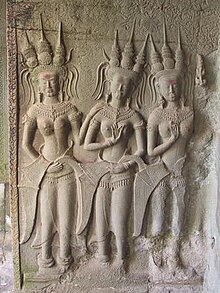This is an old revision of this page, as edited by Dangerous-Boy (talk | contribs) at 01:54, 15 February 2005 (changed stub). The present address (URL) is a permanent link to this revision, which may differ significantly from the current revision.
Revision as of 01:54, 15 February 2005 by Dangerous-Boy (talk | contribs) (changed stub)(diff) ← Previous revision | Latest revision (diff) | Newer revision → (diff)
Apsaras, the celestial entertainers of Indra's court are said to be able to change their shapes at will. Urvasi, Menaka, Rambha and Tilottama are the most famous among Apsaras who are well versed in the art of music and dancing. The total number of Apsaras at Indra's court is 23, each representing an distinct aspect of the performing art. (compare with the ancient Greek muse).
Apsaras are the wives of the Gandharva's, court servants of Indra. They danced to the music made by their husbands, usually in the various gods' palaces. In India, it is popularly believed that some of the outstanding Odissi and Bharata Natyam dancers, such as Medha Hari, are the incarnations of apsaras.
The Apsara was associated with fertility rites. In Hinduism, the lower Apsaras (also Vrikshakas, fairies) are sometimes referred to as nature spirits.
The Apsara were very beautiful and sometimes lured men to their deaths.
Apsaras are often depicted in Buddhist art as far afield as Cambodia and China, however.

